GEISHAS
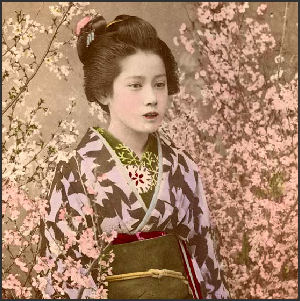
19th century geisha Geisha (meaning "art person") are women who practice the 250-year-old art of gei ("artistic skills"), and have traditionally entertained and charmed wealthy customers men with music, dance, song and witty conversation. Some think they look dolls. By en large men are supposed to admire but not touch. [Source: Jodi Cobb, National Geographic, October 1995]
"Through discipline and talent, the geisha has created a life of beauty. She has made herself into the image of the perfect woman, the embodiment of Japanese culture and refinement, a living work of art," wrote Jodi Cobb in National Geographic. "Her business is to sell a dream — of luxury, romance, and exclusivity — to the wealthiest and most powerful men in Japan. Inside the most expensive restaurants and tea houses, as men conduct delicate business negotiations, geisha pour sake and keep the conversation flowing — at a cost of thousands of dollars."
Being a geisha was one of the few ways a woman — or even a person — of “common birth could achieve wealth, status and fame. In the old days many geisha married influential samurai-turned-politicians and used their connections and skills to advance their husband’s careers.
“ Nagareru “ (“Flowing”), a novel written by Aya Koda in 1955, deals with the gradual collapse of a geisha house as seen through the eyes of a maid named Rika. Koda's writing includes some stream-of-consciousness type of elements, in which events at hand serve as a trigger for Rika's thoughts, expressed in the third person. [Source: Kate Elwood, Daily Yomiuri, May 24, 2010]
Websites and Resources
Good Websites and Sources: Immortal Geisha immortalgeisha.com ; Liza Dalby’s Geisha site lizadalby.com/LD/geisha ; Geisha, My Story thekeep.org/~kunoichi ; E-Book: Working Women of Japan (1915), containing a section on Geishas uoregon.edu/ec/e-asia/read/workingwomenofjapan ; A Maiko’s Account of Her Apprenticeship shinmonso.com/english/maiko ; Geisha Photos phototravels.net/japan ; Books: “Women of the Pleasure Quarters: The Secret History of the Geisha” by Tracy Dalby (2001, Broadway); “Geisha” by Jodi Cobb (1995, Alfred A. Knopf); “Geisha: The Secret History of a Vanishing World” by Lesley Downer (Headline, 2000); “Autobiography of a Geisha” by Sayo Matsuda (Columbia University Press, 2003); “A Geisha’s Journey, My Life as Kyoto Apprentice” By Naoyuki Ogino (Kodansha International , 2007), the story of a teenage schoolgirl who become a geisha.
Photos and Videos Good Photos at Japan-Photo Archive japan-photo.de ; Maiko Gallery art-e-zine.co.uk ; Photos of Gion Geisha khulsey.com ; Video of Maiko Putting on Make Up YouTube ; Geisha Dance Video robpongi.com ; Video of Maiko Going to Work YouTube ; Bookbrowse on the book “ Memoirs of a Geisha “ bookbrowse.com ; “ Memoirs of a Geisha film “ sonypictures.com/homevideo/memoirsofageisha
Gion is the main geisha district in Kyoto . Websites Japan Guide japan-guide.com. Gion Corner at Yasaka Kaikan Hall features a one-hour show with quick demonstrations of seven different traditional art forms: the tea ceremony, flower arranging, koto music, “gagaku” (ancient court music), “kyogen” (traditionally comic drama), bunraku puppet drama and geisha-style women dances. Shows in English are conducted twice daily at 8:00pm and 9:10pm March through November. Website: Gion Corner kyoto-gion-corner.info. Kyoto Gion Hatanaka offers a night of food, entertainment with drinking games, food and a chat with maiko with an English interpreter and a an informal photograph session. For more information call tel. (075)-541-5315 or check their website Kyoto Gion Hatanaka ; Geisha Transformation Centers: Kyoto Tourist Information Center can provide you with list and information on Geisha Transformation Centers. Call tel. 9742-(075)-371-5649. For a more authentic “tayu” look, complete makeovers are offered by the Japan Hairstyle Museum ( tel. 9742- 075-551-9071) for ¥50,000. Website: Bzzangent bzzagent.com
Links in this Website: GEISHAS Factsanddetails.com/Japan ; GEISHAS AND THE MODERN WORLD Factsanddetails.com/Japan ; CLASSICAL JAPANESE MUSIC Factsanddetails.com/Japan ; JAPANESE FOLK MUSIC AND ENKA Factsanddetails.com/Japan ; DANCE IN JAPAN Factsanddetails.com/Japan ; HOLLYWOOD FILMS ABOUT JAPAN Factsanddetails.com/Japan ; JAPANESE WOMEN Factsanddetails.com/Japan ; TAKARAZUKA, JAPANESE ALL-FEMALE THEATER Factsanddetails.com/Japan ;
History of Geishas
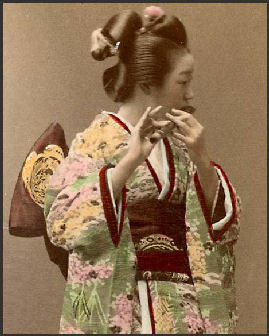
19th century geisha
playing a flute Geishas first appeared in brothels in the pleasure quarters of Tokyo and Osaka in the 17th century. Their job was to entertain bar and inn customers with dancing and music. A “geiko” (literally "arts child") is the Kyoto expression for a geisha.
The earliest geishas were men known as “taiko-mouchi” (literally "drum carrier"). Like their female counterparts today, they charmed male clients with conservation, service, performances and sexual innuendo. There were around a half dozen “taiko-mouchi” still alive in the 1990s.
It wasn't until the mid 18th century that the geisha profession was dominated by women. In the 19th century geishas were the equivalent of supermodels. The most well-known ones earned substantial incomes and influenced fashion and popular culture. In a world where women were either wives of prostitutes, geisha lived in separate communities known as the "flower and willow world."
Western fascination with geishas began when Japan opened up to the West in the late 19th century and was spurred on by a popular British musical play “The Geisha” (1896) and Puccini's “Madame Butterfly” (1904), which wasn't about geishas but featured a woman thatdressed like one. Japan, encouraged the image, sending geishas to represent Japan at world exhibitions.
Much of the interest in Japan by the West at the turn of the 21st century can be traced back to a single geisha, Sadayakko (1871-1946), who was deflowered by Prime Minister Hirobumi Ito at the age of 13 and was a famous singer and dancer. She toured the United States and Europe in 1899-1902 and drew the attention of Picasso, Gide and Puccini among others. Describing her performance Paul Morand wrote: “She acts in a setting of paper, of lanterns, of quaintness, of hallucination, of acrobatics and of charm. Her dialogue is tender, feline, lunar, hysterical, her real accent is that of cunning, or wan anger, or madness.” [Book: “Madame Sadayakko: The Geisha Who Bewitched the West” by Lesley Downer (Gotham Books, 2003)]
Geishas and courtesans were different. They had different skills and could even be identified by their different styles of clothing and housing. After World War II “geisha girl” became a slang term used by American soldiers to describe prostitutes.
Geishas, Sex and Prostitutes
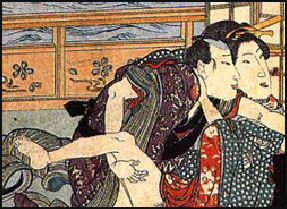
Part of the Western fascination with geisha is rooted in the belief that they were highly decorated, high-class prostitutes. Many Japanese insist that geishas are not prostitutes at all but skilled performers. The truth is somewhere in between and varies from case to case.
Geishas have generally not been prostitutes. Part of their allure has been the suggestion not the reality of sex. However, on occasion, if the mood, the man and the money were right, they sold their bodies or served as mistresses to wealthy men who took care of them, but they are not supposed to utter one word about it.
In the old days, there was often a distinction between geishas who worked as prostitutes and those that didn't. Geishas who worked at hot spring resorts were the lowest status geishas. For them sex was not a remote possibility but something that was expected of them. These women earned “points” by sleeping with customers that went to paying off the debt they owed their geisha houses.
A Tokyo geisha told the Japan Times that the Prostitution Prevention Law of 1957 changed things. "In the old days, geisha did as they were told,” she said. "Today's women are much more independent."
The likelihood of a typical customer, particularly a foreigner, having sex with a geisha is extremely unlikely. Part of the geishas training includes how to politely deflect offers of dates and unwanted advances. The virginity of geishas was sometimes auctioned off to the highest bidder in ritual known as “mizuage” ("deflowering"). Some men paid the equivalent of tens of thousands of dollars for the privilege.
Geisha Patrons, and Girls Sold to Geisha Houses

geisha house owner Male patrons were called “danna” ("husbands"). Not only were they supposed to maintain the geishas like mistresses they paid for her kimonos, accessories and training. The total cost could run in the equivalent of hundred of thousands of dollars.
Danna often supported a geisha for decades. In return the geisha was supposed to be devoted to him exclusively. Few geisha ever married their dannas even after their wives died and even though they gave birth to the danna's children.
Since the Meiji era in the late 19th century many geishas have been organized into by a system, run by a kenban, or agency, which dispatches geisha to ryotei in certain areas. Since then 50 areas gave been designated as “hanamachi,” or entertainment districts, Gion in Kyoto is perhaps the most famous hanamichi.
Up until World War II, women who were geishas had no choice but to be geishas. They were born into the trade or forced to join it to survive. Many were girls who were sold by their parents to geisha houses and became virtual slaves.
Many of these girls were sold to the geisha houses when the around five. They worked as house servants and maids until they were old enough for their training to begin. The geisha houses looked upon the girls as investments and kept the girls from leaving by obligating them to pay off their debt for training and maintenance. The custom of “mizuage” was created in part to help the girls pay off their debt.
Maikos, Honor and Male Geisha
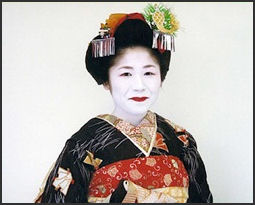
maiko at her debut “Maikos” are geisha apprentices. To become one takes a year of training. Afterwards they endure several more years of training to became a geisha. Maikos are often decked out in flamboyant colors while geishas tend to be more demurely dressed. Many pictures that one sees of geisha are actually of maikos.
Maikos are sort of like medical students doing their residency. They participate in the entertainment of customers under the supervision of geishas. A maiko typical becomes a geisha when she is around 20. In the old days, a maiko sometimes became a full-fledged geisha after her “mizuage” ("deflowering"). These days many maiko never become geishas. They leave the geisha houses when they are in their early 20s and get married and live normal lives.
Geishas follow a strict samurai-like code of honor which prizes discretion and forbids geishas from revealing anything about their private lives or the private lives of the their male customers.
The reputations of geishas was badly tarnished in 1989, when one geisha talked about her affair with then Prime Minister Sosuke Uno, causing his party to suffer a humiliating defeat in the following election. Two years later another geisha sued a Kyoto training center, where she was being taught, claiming she was abused and underpaid. A settlement was reached out of court. The confessions by the geisha that provided material for the novel “Memoirs of a Geisha” also broke this code of honor.
There is such a thing as male geishas. Also known as “hokan” or as “talko-mochi” (“drum bearer”), they are like court jesters and undergo some of the same training as geishas in dance, music and manner. One who works in the Asakusa district told the Asahi Shimbin, “Another good description of my job is whipping boy for company presidents.” He said he said getting yelled at is part of his job. “That’s what the host is paying for, he want to be able to scream at someone in front of an audience, I don’t take it personally.”
Geisha Training

singing lesson Girls that decide to become geisha today do so out of choice. Most enter a geisha house when are 14 or 15, after they have graduated from middle school. Many join without parental approval. Those that live in the geisha houses develop mother-daughter relationships with the geishas that run the house and refer to them as "mother."
Maikos endure a strict military-like training that takes up most of their time. They study etiquette, the ways of men, walking with quiet, shuffling steps, and traditional arts such as the tea ceremony, flower arranging, calligraphy and classical fan and umbrella dancing and learn to play the banjo-like the “samisen”.
Maiko are taught to eat tofu and fish with touching the food to their artfully lacquered lips and learn to bow by kneeling with their body straight so that just the tips of their outstretched fingers touch the tatami. They are not supposed to touch their palms of forearms to the floor. During winter training they have to stand out on a balcony and sing. During the summer heat they have to serve hot tea while wearing their full geisha regalia. Many maikos say they often think about quitting during their training.
Maiko training in Kyoto is very strict. Those who come from outside Kyoto have to acquire a Kyoto accent. Geisha apprentices from Tokyo can't talk to their families on the phone out of worries that her Kyoto accent would be tarnished. Only about of one of 10 trainees actually becomes a maiko.
These days the training is much less rigorous than it used to be. Girls start much later than they used to and are allowed to take a day off if they are tired or have a hangover. If the training is too hard the girls quit.
A geisha in Akasake, Tokyo told the Daily Yomiuri, “real geisha are educated in every field and act as if they’re part of the elite, despite having to suffer through hard times...An Akasaka geisha can be likened to a peony. It’s more colorful than say, a lily, and peonies are overwhelmingly beautiful. I want my younger colleagues to feel the vigor and flamboyancy of a peony.”
Geisha Duties

performing a classical dance Geishas live in a world of obscure rules and etiquette in which there is a state and a backstage. One geisha told the Daily Yomiuri, "Our function has always been that of mediators for customers conducting business, We maintain utmost obedience to them. If one customer says crows are white, we just smile and agree. In this sense, we are no different from hostesses."
Before each meal geisha is Akasuka, Tokyo say: “Our minds are one of loyalty, reflection and gratitude. We give love to people, give water to flowers. We shouldn’t forget our first intentions; an excuse is merely an objection in disguise.”
Geishas spend a lot of time pouring drinks and, in many cases, drinking. One geisha told the Japan Times, "You need to be able to drink. You have to drink every day. The customers are usually drunk and they try to get us drunk."
Geisha are taught to go uh huh, uh huh and not offer their opinions. A Tokyo geisha told Cobb, "In this world the man holds the higher position, and the woman follows him. That's the way it should be. I must help and support him but not let him know. This a woman's virtue: to be strong on the inside but not let it show."
One geisha told the New York Times, "There is a technique to good listening. It may sound impolite to wives, but men have a world that wives cannot understand. Men release their inner self in a place like this and then go home. Professional women can draw out a man’s inner self, but it requires experience. You can only do that after your 40s." One geisha told the Japan Times. "The golden rule os not to forget were in a trade that sells dreams. It's taboo to talk about everyday stuff."
Geisha activities and movements are carefully crafted. Bruce Wallace wrote in the Los Angeles Times: “Every move...is rooted on Japanese ritual...The way her body sinks to a kneel, or she uses just the fingertips of her right hand to slide open wood-framed Japanese doors. The way she moves like smoke across the room on dancer’s toes...every action is a piece of performance art based on Japanese tales whispered down through the generations.”
Dancing and instrument playing are expected to be heartfelt. A retired geisha told the Los Angeles Times, “The dances are not just action; they are stories from our history, and you have to know that history to express it.”
Working Geisha
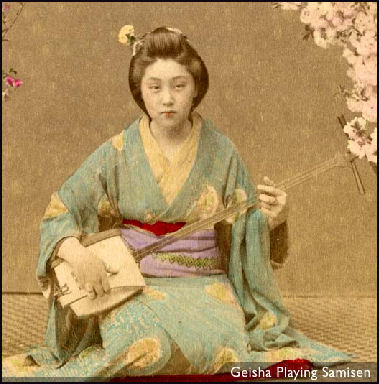
Geisha work at nightly parties that often go into the wee hours of the morning. They receive generous wages and tips but they also have pay thousands of dollars for expensive silk kimonos and other clothes and items. Geishas are not allowed to marry so many of them take older lovers "for financial and emotional support."
A typical geisha is paid about $300 for a night’s work but has a lot of overhead. She has to pay $500 a month in registration fees, $500 a months on loan payments for her kimono, $600 a month for hairstyling and $500 a month for singing, dancing and music lessons.
Most geishas go by a single professional name. Some geishas have specialties. Golf-geishas are particularly skilled in chatting with clients about golf. Others are good at playing games that men find amusing. Those that dance, sing and play an instrument are taught to do so with an expressionless face.
In the old days geisha often lived and worked at the same place. This is no longer the case. One geisha told the Japan Times, "Nowadays we are like regular office workers and the okiya is an office to which we commute from the suburbs."
A typical day for a typical geisha begins at around 9:00am with breakfast followed by errands, household chores and singing and instrument practice and maybe some dance exercises. She takes a bath and begin preparing for work at around 6:00pm. Work usually ends around 1:00am and about an hour is needed to remove the make up and take off the kimono.
Career Geisha
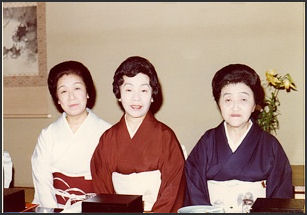
The routine day in and out does a take its toll. A Kyoto geisha told Cobb, "I'm tired of people's eyes. I'm tired of pretending to be someone I'm, tired of flattery. I would love to be thought of as a frank and honest person, speaking and acting as I really feel. But this business won't allow that."
One geisha in Atami told the Asahi Shimbun said she became a geisha for the money after she was forced to quite her company job because of health problems and she needed to pay off a car loan. “I started part time and then I was hooked, Being a geisha is not fun in the beginning, but you arrive at a stage where you enjoy it.”
The endless nights of cigarette smoke and singing over many years also take their toll. Many veteran geishas have a gruff, deep voice. Some even have polyps on their throat. As they get older and wrinkles collect on their faces, their conversations take on a more salty, drinking buddy tone to make up for their lack of youth and described their jib as “stress relief for men.”
Some geisha continue working until they are well into their eighties. The famous geisha, Haru Kato, performed almost until the day she died at age of 102 in 1996. In 2005, the oldest working geisha was 96. Today most geishas retire before they are forty.
One geisha told the Los Angeles Times, “When I look at geishas portrayed on TV or in movies — even Japanese movies — I shouldn’t laugh, but it is totally different from our lives.”
Geisha Costume
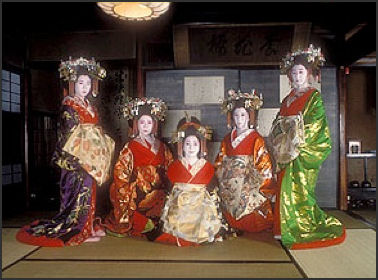
Geishas wear a bright outer kimono, two under-kimonos, 11 obis (belts and sashes); lacquer their hair and place ornaments in it; and apply layers of paint and make up. Before the geishas put on their kimonos they apply white powdered make-up on the faces and paint to their necks and backs. Some geishas paint their teeth black, a custom once considered beautiful for women.
Putting on the obis and kimonos is like going through a maze to a complete a jigsaw puzzle. It takes geishas about three hours to put their make-up on and the costume, which often costs more than $30,000. Young helpers and an "auntie" often help the geishas to get dressed. A man is sometime necessary to do the strenuous parts of putting on the obi.
Geisha clothes weigh 10 kilograms. "An obi is like a man's necktie." a Tokyo geisha told Cobb. "You tie it tight, and you become upright and rigid. I'm like a businessman putting on a suit in the morning, preparing for his daily battle, forgetting his personal life. When I put on make-up and a kimono, I turn into a geisha in my mind also. In a kimono, I am a professional."
One Kyoto client told Cobb, "I have seen how geisha prepare their makeup, but I don't like to. I want the romantic ideal, not the reality. I don't want to know the trick. I don't want t known their sad stories. I want to keep it as a dream, and they want to keep it as a dream for me. That's the business."
Geisha Hairdos
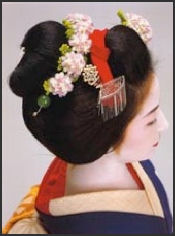
older maiko hairstyle Geisha hairdos are created with the geisha’s hair, and human and animal hair extensions that are held in place with wax, silk ribbons and inner bindings made of absorbent Japanese paper. A hairdo can weigh up to three kilograms.
Styling a geisha hairdo can cost ¥20,000 each time its done, Geisha sometimes sleep on wooden neck rest so as not to mess up their hairdos. The hot irons and wax used to create the hairdos take their told and leave geisha with bald spots when they get old. These are sometimes hidden with wax and yak hair.
The hairdressers who prepare a geisha’s hair are known a “keppatsu-shi”. Describing Kyoto’s only male “keppatsu-shi” at work, Anthony Faiola wrote in the Washington Post, “Now this won’t hurt a bit,” he said wryly, raising his handmade, $300 comb designed specifically for geisha hair. He dragged it roughly through the remaining pots of wax in her tumbling locks...After rapidly applying the right thickness of wax according to the day’s humidity, he tied a string of paper to hold her hair in place, tightening it with his teeth. He then put his hands on her porcelain-white neck, stuffing in required patches of yak hair to give her a variation of the split-peach geisha hairdo that some Japanese consider highly suggestive.”
Hairpins worn by geisha can be quite elaborate and change according to the season with as many as 20 variations worn at different times of the year. A hairpin worn by an experienced maiko during the Gion Festival has five tiers of 110 flowers and butterflies with blue fabric. One worn by a maiko with only a few years experience has three tiers with 48 silver flowers and four butterflies. Flowor decoration are made from heavy paper doubled over and put on a wire and fixed with silk thread. Butterflies are made with heron or stork feathers. A skilled craftsman can make only one or two hairpins a day.
Geisha Houses, Ryotei and Parties

tea house The geisha houses in Gion, Kyoto's famous pleasure district, are located in nondescript two-story houses with wooden facades and bamboo shades that prevent people from looking inside. A discreet, white lit-up sign identifies the geisha house. A signboard list the geisha and maiko that work there. The only time geishas perform in public is when maikos do dances during the annual Cherry Blossom Dances in Kyoto.
Many geisha work in tearooms, that generally serve much larger quantities of alcohol than tea, and “ryotei”, traditional inns made up of a mazelike configuration of private, screened rooms, where businessmen and politicians met to make deals while being entertained by geisha. Some have secret stairways and passageways so VIPs who don't see each other can avoid chance encounters. Ryotei have traditionally not published their prices, which are said to be very high.
Small parties are usually entertained by three geishas: a “tachikata” (dancer), “jikata” (samisen player) and a maiko. The maiko unusually engages the guests in conversation, while the other geishas perform. When the other two aren't performing they are usually making sure their guest's sake glasses are filled they have enough to eat.
An single evening of geisha entertainment can easily set back each participant $1,500, but more typically costs each person between $500 and $800. Women are allowed to attend geisha outing but they rarely come. Men can also arrange to meet a geisha at a bar or some other place. The cost can range from $500 to $2,500 pending on the setting and the number of people involved.
Ordinary people usually can not gain access to a geisha house. New customers normally have to be introduced a loyal and valued customers who has been doing business with the geisha house for years.
Night Out with Geisha
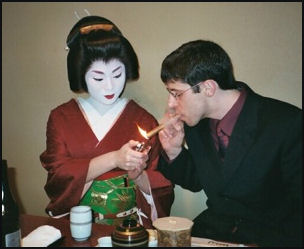
Describing a private party at a Kyoto geisha house, Cobb wrote, "As the men sit down for dinner, geisha kneel at their sides, flirting and smiling, offering delicacies and pouring sake. When the alcohol kicks in, ties and tongues loosen. The geisha play party tricks, strum samisen, and sing bawdy songs. They provide an illusion of romance in a work-obsessed culture that has little opportunity for the real thing."
"The geisha's skill in conversation," Cobb wrote, is what "Japanese men claim to appreciate the most. She is fluent in news of the day and the gossip of the theater or sumo world. She has studied the male ego and tends it like a garden. She knows a man's moods and his seasons. She fusses, and he blooms."
One American who indulges himself with a night with a geisha from time to time told the Daily Yomiuri, he begins his night with a geisha by a visit to a bar and follows that up with a trip to a regular tea house. "I try to entertain the young maiko-san and take them to some of the places they haven't been before and wouldn't go with older customers. In that way it's kind of a friendship relationship, but that's only when the tab's running."
At geisha parties there is usually a lot of good food and alcohol. Geishas and maikos often have litle party games they play with their customers.
A one-hour geisha performances staged for tourists starts with two “nagauta” (long epic songs) about cheery blossom view or some such thing sung by geisha standing upright in front of a music stand accompanied two shamisen, a flute, a taiko drum and large and small hand drums. This is followed by a elegant “Kyo no Shiki” dance performed by two women and a “Yozakuraya” dance, representing a drunken man performed by a geisha with a kanzashi hair stick which indicates he is playing a male role. The performances close with comical skit and dance by a male performer.
GION

Gion (Sijo train station) is Kyoto's most famous entertainment district. Located on the east side of the Kamogawa River, it is a good place to experience traditional Japanese culture or see some of the last geisha houses in Japan. The section of Gion between Shirakawa-Minamirdori Street and Shinbashidori Street has been designated a Historic Preservation Zone.
Traditional wooden townhouses found in Gion and elsewhere in Kyoto are called “machiya” . A typical one is six meters wide and 30 meters deep, has six tatami mat rooms, and is worth about $420,000. Many have lattice windows, stripped beams, Older unrestored ones have dirt floors and mushikomado windows framed by thick clay. They are designed to let cool breezes in during the summer. Today there are only 30,000 of them left (compared to 600,000 modern homes). Many were built by merchants in the Edo period. Today, preservationists are trying to keep the remaining machiya houses from being turn down. The best place to see then is around Kiyomizu-dera Temple in eastern Kyoto.
Ichiriki Ochaya, in the heart of Gion, is one of Japan’s most famous and exclusive entertainment establishments. Patronized b powerful and well-connected business leaders and politicians, it welcomes guests on an invitation only basis with the invitation sometimes taking generations to get. Food, drinks and geisha entertainment begins at around $8,000.
English-language tours of the Gion are sponsored by the Kyoto City Tourist Association in July, August and September. The 100-minute tours begins across from the Minami-za kabuki theater and stops at scenic spots such as Gion Shinbashi and Tatsuminbashi, both known for their old machiya houses and beautiful stone streets,, and Gion’s busy Hanamikoji street, where participants may catch glimpses of maiko and geisha. The tour fee is ¥1,000 per person. For information call (075)-752-0227. Website: Japan Guide japan-guide.com
Places in the Gion Area
Gion Corner (10-minute walk Gion Bus Stop, 20 minutes by bus No.206 from Kyoto Station) at Yasaka Kaikan Hall features a one-hour show with quick demonstrations of seven different traditional art forms: the tea ceremony, flower arranging, koto music, “gagaku” (ancient court music), “kyogen” (traditionally comic drama), bunraku puppet drama and geisha-style women dances. Gion Corner is especially popular with foreign visitors. Show Times Show starts at 6:00pm and 7:00pm everyday (Friday, Saturday, Sunday and national holidays in December-March). There are no performance on July 16, August 16 and December 29-January 3. Admission: 3,150 yen; Website: kyoto-gion-corner.info, Tel:075-561-1119
Kenninji Temple (near Gion) is the oldest Zen temple in Kyoto. Built in 1202 by the Priest Yosai (Eisai, 1141-1215), who is credited with introducing tea to Japan, the temple houses “Fuji-Raijin-zu”, a folded screen painting of the gods of wind and thunder made by famous painter Tawaraya Sotatsu in the 1600s. Unfortunately the painting and the temple’s other treasures are not always displayed. A small tea garden with bushes from China are located near a cenotaph commemorating Eisai.
Okazaki District (north of Gion) features narrow streets lined with traditional houses with weathered pine beams and grey tile roofs. Along side many of the houses are small gardens of ferns and bonsai trees surrounded by bamboo fences and brown stucco walls. Quiet and serene, it is only a block away from Marutamachi Dori, one of Kyoto's busiest shopping streets.
Maiko Theater (Higashiyama Ward) features maiko, young geisha-like female entertainers and has become popular with tourists from abroad. Jiji News reported: “At the Maiko Theater, launched in late 2016, audiences can enjoy dance performances by maiko and eat and drink with the apprentice female entertainers, who are in the process of learning traditional dance and music.“Anybody may enter the theater for a fixed charge, according to the operator. It is generally thought to be difficult to see maiko performances in Kyoto as many places offering such shows in Japan’s ancient capital refuse first-time customers. “I’ve wanted people to know the attraction of the culture of the hanamachi [geisha district],” said Kugu Tomoko, a representative of the maiko theater. “I’ve hoped to create a place where visitors can see maiko easily.” “Some 80 to 90 percent of the audience are foreigners. But, surprisingly, some people come from Kyoto,” said Kugu, whose parents runs a restaurant in which maiko and senior female entertainers perform and provide accommodation for them. [Source: Jiji Press, May 13, 2017]
Geishas in Gion
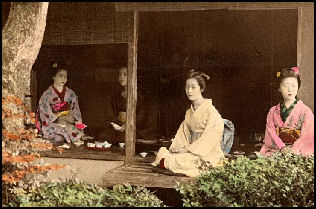
19th century Kyoto tea house Gion is the home of the largest concentration of geishas and maikos (geisha apprentices) left in Japan today. The geisha houses are located in nondescript two-story machiya houses with wooden facades and bamboo shades that prevent people from looking inside. Since going inside a geisha houses is beyond the means of most people, your best chance of seeing a geisha live and in the flesh is to walk through Gion in the late afternoon when the geishas show up for work.
Several traditional teahouses and restaurants where geisha perform are located along Hananami-koji. Gion had 218 traditional teahouses, where geisha performed, in 1950; 123 in 1981; but only 80 on in 2000. There are four other geisha districts in Kyoto.
In the past geisha teahouses were the exclusive province of elite members and not open to just anybody but in recent years this exclusive clientele has dried up somewhat and geisha and the teahouses are looking for new sources of income. Gion and Pontocho and other places in Kyoto are now offering tourists a chance to experience geisha culture. These events are usually held at restaurants or hotels, not the teahouses and cost between ¥6,000 and ¥13,000 yen and feature a short chat with a couple of maiko geisha and performance of Kyomai dance. Programs ate sponsored by the Kyoto Tabi Kikakum tour company in Fushimi Ward in Kyoto.
Sometimes large groups of tourist flock to Gion in the evening to catch sight of geiko and maiko walking to work. There have been reports of tourists harassing the maiko. See Arts, Culture; Noh, Kabuki...Geisha. Websites: Kyoto and Gion geisha insidekyoto.com ; Geisha story thekeep.org
Harassment of Geisha
Geiko and maiko in Gion have complained about being harassed by tourists who pester them for photographs and ogle at them as they walk to work. One 18-year-old maiko told the Yomiuri Shimbun, people “approach me without saying a word and suddenly stand beside me to have photographs, so I get taken by surprise.” Other have said tourists have tugged hard at their sleeves, causing them to nearly fall on their “ okobo” (“platform shoes”).
To help the Gion maikos and geikos messages have been posted on Kyoto’s English-language Web Site asking foreign tourist not to bother them. Residents and owners of restaurants in Gion escort the women to work and intervene is they are bothered.
Image Sources: 1) 2) 6) 8) Visualizing Culture, MIT Education 3) Japan Visitir, 4) 5) 7) 9), 10), 11), 13) Liza Dalby's geisha website 12, Ray Kinnane; Kyoto Prefecture Tourism
Text Sources: JNTO (Japan National Tourist Organization), Japan.org, Japan News, Japan Times, Yomiuri Shimbun, Japan Ministry of the Environment, UNESCO, Japan Guide website, Lonely Planet guides, New York Times, Washington Post, Los Angeles Times, National Geographic, The New Yorker, Bloomberg, Reuters, Associated Press, AFP, Compton's Encyclopedia and various books and other publications.
Updated in July 2020
